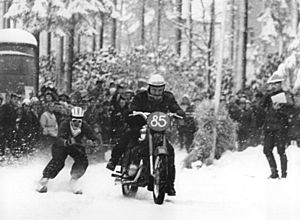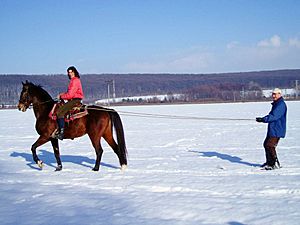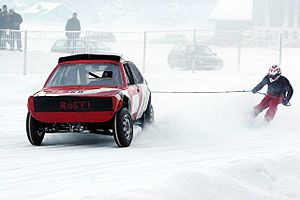Skijoring facts for kids
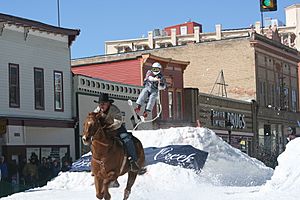
Skijor racing with horses
|
|
| Characteristics | |
|---|---|
| Mixed-sex | Yes |
| Type | Outdoor |
| Equipment |
|
| Venue |
|
| Presence | |
| Olympic | Exhibition 1928 |
Skijoring is a cool winter sport. It involves a person on skis being pulled. This can be by a horse, one or more dogs, or even a motor vehicle. The name comes from the Norwegian word skikjøring. This means "ski driving." Skijoring started as a way to travel in winter. Now, it's mostly a fun competitive sport.
Contents
History of Skijoring
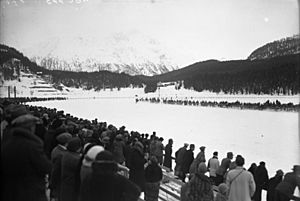
For hundreds of years, the Sami people used reindeer for travel. They would harness reindeer and ski across snowy lands. Skijoring with reindeer was first seen at the Nordic Games. This happened in Stockholm in 1901, 1905, and 1909. It is still popular in countries like Norway and Finland. Reindeer races are still held today.
By 1912, skijoring with horses became popular. This was in places like Switzerland and France. Horse skijoring then came to North America. It was a fun activity in Lake Placid, New York, by 1915. It also became a regular event at the Dartmouth Winter Carnival.
In 1924, horse skijoring was part of the International Winter Sports Week. This led to it being shown at the 1928 Winter Olympics in St. Moritz, Switzerland.
After World War II, soldiers from the 10th Mountain Division saw skijoring in Europe. They brought the idea back to the American West. Cowboys made it simpler. They tied a long rope to a western saddle. The skier held on as the horse galloped. This was often in an open field or on a snowy road.
Towns like Jackson Hole, Wyoming and Steamboat Springs, Colorado started the sport. Early races had many teams racing side by side. This might be how modern American races began. The city of Leadville, Colorado held its first race in 1949. This race is still held today.
In the 1950s, skiers were sometimes pulled by motorcycles or cars. Today, in Latvia, skiers are pulled in a motocross-style event. In Alaska, skiers are pulled by snowmobiles going very fast. In the United Kingdom, skijoring happens on grass or in arenas. Some places in France and the Caribbean even do skijoring on beaches!
Dog Skijoring
Some people think dog skijoring started in China. A historian wrote about it during the Yuan and Ming dynasties (1271–1644). He said, "tens of dogs pull a person on a pair of wooden boards... galloping on the snow and ice faster than a horse."
Today, dog skijoring helps a cross-country skier. Usually, one to three dogs are used. The skier uses their skis and poles for power. The dog adds more power by running and pulling. The skier wears a special harness. The dog wears a sled dog harness. They are connected by a rope. There are no reins to control the dog. The dog must want to run and listen to voice commands.
Many types of dogs can do skijoring. They just need to enjoy running and pulling. Small dogs are not often seen, as they don't add much power. But any excited dog can join in! Athletic dogs like pointers and sled dog breeds love skijoring. Many other large, energetic dogs also do this sport.
Dog skijoring is done for fun and in competitions. It can be for long distances or short, fast races.
Dog Skijoring Competitions
Many dogs naturally pull a skier. So, the sport doesn't have one country where it started. But as a competition, it likely began in Scandinavia. It grew from an older sport called pulka.
Skijor races happen in many snowy countries. Most races are between 5 and 20 kilometers long. The longest race is the Kalevala in Russia, which is 440 kilometers! In the US and Canada, skijoring races often happen with sled dog races.
Some races are local club events. But many are part of international groups. In the US and Canada, ISDRA (International Sled Dog Racing Association) helps organize races. In Europe, ESDRA (European Sled Dog Racing Association) does this. The IFSS (International Federation of Sleddog Sports) organizes World Cup races. They also have a world championship every two years. At the IFSS World Championship, skijoring races are split. There are categories for men and women, and for one-dog or two-dog teams. In 2011, Minneapolis, USA, had the biggest skijoring event. Two hundred teams raced there.
Dog Skijoring Equipment
The skier wears a wide belt called a skijoring belt. It clips around the waist. It might have leg loops to keep it in place. Rock climbing harnesses are also often used.
The dog wears a sled dog harness. These are common for dogsled racing.
The skijoring line is usually at least 2.5 meters (8 feet) long. A longer line is used for three dogs. A bungee cord is often in the line. This helps absorb the dog's pull or a sudden stop. Special quick-release hooks are available. These let the skier unhook the dog fast.
Dog Skijoring Techniques and Training
The skier uses either classic cross-country skiing or skate skiing. Skate skiing is faster and used in most races. Skis are waxed to be very slippery. This helps the dog team go fast.
Skijoring dogs learn commands like sled dogs. They learn to start (hike), turn (gee for right, haw for left), and stop (whoa). They also learn to ignore distractions (on by). It's best to train dogs on foot first. This helps avoid crashes into trees!
For races, dogs must learn to pass other teams. They also need to be passed without causing problems. A dog that tries to stop and greet another team can be a problem. A dog that tries to nip other dogs is also bad. Top racing teams can pass other teams without even looking at them.
Equestrian Skijoring
Equestrian skijoring usually has a team of two people and a horse. One person rides the horse. The other person is on skis. The skier holds a tow rope, like in water skiing. They don't use poles. In some parts of Europe, the horse has no rider. The skier guides the horse. Races happen on snowy fields, streets, or even horse racetracks.
Horses gallop down a track about 900 to 1200 feet long. Skiers must go over jumps and through gates. At some events, skiers grab rings as they pass a station. This makes it harder. On a straight track, the horse runs down the middle. The skier goes through slalom gates and jumps on the sides. Some places use a horseshoe-shaped track. The horse runs inside, and the skier jumps on the outside. Jumps are 2 to 7 feet high. They are lower on curved tracks or for snowboarders.
Some events have fun challenges. One is a long jump competition. The horse pulls a skier who jumps for the longest distance. Competitors have jumped as far as 56 feet!
Equestrian Skijoring Equipment
Competitors often use short skis. They use special towing gear, like for water skiing. Sometimes, it's just a rope tied to the saddle. Some setups use two ropes. These attach to the back of the saddle or a breastplate on the horse.
Timing is usually electronic. Top races are decided by tiny fractions of a second. There are usually three skill levels: Pro/Open, Sport, and Novice. There might be age groups. There can also be separate events for women or snowboarders. Sometimes, 100 teams race each day. Prizes can be over $20,000.
Horses are trained to be calm around ropes and skiers. They also learn to stay calm during races. The skier's time is recorded. Penalties are given for missing gates or jumps. Missing or dropping rings also gets penalties. Competitors often race for cash prizes.
Equestrian Skijoring Competition Venues
Competitive horse skijoring races happen in eight US states. Most are in the Rocky Mountains. They also happen in St. Moritz, Switzerland and Alberta, Canada. There are different types of the sport in many countries. These include France, Denmark, Norway, Sweden, and Russia.
In Europe, horse skijoring is very popular at White Turf. This event is in St. Moritz, Switzerland. White Turf started in 1907. It has horse racing on snow, chariot racing, and skijoring. Over 35,000 people watch each day.
In the United States, Leadville, Colorado has had a race since 1949. It runs down the main street. Leadville held its 71st race in 2019. Steamboat Springs, Colorado says skijoring has been part of its Winter Carnival for over 100 years. Other big events include the Whitefish Winter Carnival. This event has hosted the World Skijoring Championships. In 2011, this event gave out almost $20,000 in prizes.
Other US race locations include towns in Montana, Idaho, Wyoming, Utah, and Colorado. In 2019, Steamboat Springs, Colorado, hosted a new competitive race. Canterbury Park, Minnesota, and Skowhegan, Maine, also had races in 2019.
Equestrian Skijoring Organizations
Skijor International started in 2012. Its goal is to promote horse skijoring. Skijor USA is a related group. It sponsors about 12 races. Both are non-profit organizations. They hope to bring horse skijoring back to the Winter Olympic Games. They aim for 2026 or 2030, marking 100 years of the sport. Skijoring America is a similar group. It started in 2015 and is based in Montana.
Motorized Skijoring
Skijoring can also be done behind a snowmobile. Or it can be behind another small motorized vehicle. The vehicle and driver pull a skier. This is more like the horse style. It's better for higher speeds than dog skijoring.
Another type uses an all-terrain vehicle like the Bandvagn 206. Several skiers or soldiers can be pulled on one rope. The rope goes around the skier's ski poles. Then it goes to the next person in line. Skiers hold onto their poles with their arms.
In the Media
Skijoring is in the 1998 movie Silver Wolf. It stars Michael Biehn and Roy Scheider. Skijoring is also mentioned in the short film Snow Thrills. This film was later shown on the TV show Mystery Science Theater 3000.
See also
 In Spanish: Skijöring para niños
In Spanish: Skijöring para niños
- Yak skiing
- List of equestrian sports
- Bikejoring
Images for kids


